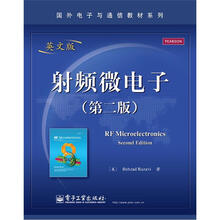射频微电子(第2版)(英文版)

目 录内容简介
CONTENTS
CHAPTER 1 INTRODUCTION TO RF AND WIRELESS TECHNOLOGY
1.1 A Wireless World
1.2 RF Design Is Challenging
1.3 The Big Picture
References
CHAPTER 2 BASIC CONCEPTS IN RF DESIGN
2.1 General Considerations
2.1.1 Units in RF Design
2.1.2 Time Variance
2.1.3 Nonlinearity
2.2 Effects of Nonlinearity
2.2.1 Harmonic Distortion
2.2.2 Gain Compression
2.2.3 Cross Modulation
2.2.4 Intermodulation
2.2.5 Cascaded Nonlinear Stages
2.2.6 AM/PM Conversion
2.3 Noise
2.3.1 Noise as a Random Process
2.3.2 Noise Spectrum
2.3.3 Effect of Transfer Function on Noise
2.3.4 Device Noise
2.3.5 Representation of Noise in Circuits
2.4 Sensitivity and Dynamic Range
2.4.1 Sensitivity
2.4.2 Dynamic Range
2.5 Passive Impedance Transformation
2.5.1 Quality Factor
2.5.2 Series-to-Parallel Conversion
2.5.3 Basic Matching Networks
2.5.4 Loss in Matching Networks
2.6 Scattering Parameters
2.7 Analysis of Nonlinear Dynamic Systems
2.7.1 Basic Considerations
2.8 Volterra Series
2.8.1 Method of Nonlinear Currents
References
Problems
CHAPTER 3 COMMUNICATION CONCEPTS
3.1 General Considerations
3.2 Analog Modulation
3.2.1 Amplitude Modulation
3.2.2 Phase and Frequency Modulation
3.3 Digital Modulation
3.3.1 Intersymbol Interference
3.3.2 Signal Constellations
3.3.3 Quadrature Modulation
3.3.4 GMSK and GFSK Modulation
3.3.5 Quadrature Amplitude Modulation
3.3.6 Orthogonal Frequency Division Multiplexing
3.4 Spectral Regrowth
3.5 Mobile RF Communications
3.6 Multiple Access Techniques
3.6.1 Time and Frequency Division Duplexing
3.6.2 Frequency-Division Multiple Access
3.6.3 Time-Division Multiple Access
3.6.4 Code-Division Multiple Access
3.7 Wireless Standards
3.7.1 GSM
3.7.2 IS-95 CDMA
3.7.3 Wideband CDMA
3.7.4 Bluetooth
3.7.5 IEEE802.11a/b/g
3.8 Appendix I: Differential Phase Shift Keying
References
Problems
CHAPTER 4 TRANSCEIVER ARCHITECTURES
4.1 General Considerations
4.2 Receiver Architectures
4.2.1 Basic Heterodyne Receivers
4.2.2 Modern Heterodyne Receivers
4.2.3 Direct-Conversion Receivers
4.2.4 Image-Reject Receivers
4.2.5 Low-IF Receivers
4.3 Transmitter Architectures
4.3.1 General Considerations
4.3.2 Direct-Conversion Transmitters
4.3.3 Modern Direct-Conversion Transmitters
4.3.4 Heterodyne Transmitters
4.3.5 Other TX Architectures
4.4 OOK Transceivers
References
Problems
CHAPTER 5 LOW-NOISE AMPLIFIERS
5.1 General Considerations
5.2 Problem of Input Matching
5.3 LNA Topologies
5.3.1 Common-Source Stage with Inductive Load
5.3.2 Common-Source Stage with Resistive Feedback
5.3.3 Common-Gate Stage
5.3.4 Cascode CS Stage with Inductive Degeneration
5.3.5 Variants of Common-Gate LNA
5.3.6 Noise-Cancelling LNAs
5.3.7 Reactance-Cancelling LNAs
5.4 Gain Switching
5.5 Band Switching
5.6 High-IP2 LNAs
5.6.1 Differential LNAs
5.6.2 Other Methods of IP2 Improvement
5.7 Nonlinearity Calculations
5.7.1 Degenerated CS Stage
5.7.2 Undegenerated CS Stage
5.7.3 Differential and Quasi-Differential Pairs
5.7.4 Degenerated Differential Pair
References
Problems
CHAPTER 6 MIXERS
6.1 General Considerations
6.1.1 Performance Parameters
6.1.2 Mixer Noise Figures
6.1.3 Single-Balanced and Double-Balanced Mixers
6.2 Passive Downconversion Mixers
6.2.1 Gain
6.2.2 LO Self-Mixing
6.2.3 Noise
6.2.4 Input Impedance
6.2.5 Current-Driven Passive Mixers
6.3 Active Downconversion Mixers
6.3.1 Conversion Gain
6.3.2 Noise in Active Mixers
6.3.3 Linearity
6.4 Improved Mixer Topologies
6.4.1 Active Mixers with Current-Source Helpers
6.4.2 Active Mixers with Enhanced Transconductance
6.4.3 Active Mixers with High IP
6.4.4 Active Mixers with Low Flicker Noise
6.5 Upconversion Mixers
6.5.1 Performance Requirements
6.5.2 Upconversion M
……
CHAPTER 1 INTRODUCTION TO RF AND WIRELESS TECHNOLOGY
1.1 A Wireless World
1.2 RF Design Is Challenging
1.3 The Big Picture
References
CHAPTER 2 BASIC CONCEPTS IN RF DESIGN
2.1 General Considerations
2.1.1 Units in RF Design
2.1.2 Time Variance
2.1.3 Nonlinearity
2.2 Effects of Nonlinearity
2.2.1 Harmonic Distortion
2.2.2 Gain Compression
2.2.3 Cross Modulation
2.2.4 Intermodulation
2.2.5 Cascaded Nonlinear Stages
2.2.6 AM/PM Conversion
2.3 Noise
2.3.1 Noise as a Random Process
2.3.2 Noise Spectrum
2.3.3 Effect of Transfer Function on Noise
2.3.4 Device Noise
2.3.5 Representation of Noise in Circuits
2.4 Sensitivity and Dynamic Range
2.4.1 Sensitivity
2.4.2 Dynamic Range
2.5 Passive Impedance Transformation
2.5.1 Quality Factor
2.5.2 Series-to-Parallel Conversion
2.5.3 Basic Matching Networks
2.5.4 Loss in Matching Networks
2.6 Scattering Parameters
2.7 Analysis of Nonlinear Dynamic Systems
2.7.1 Basic Considerations
2.8 Volterra Series
2.8.1 Method of Nonlinear Currents
References
Problems
CHAPTER 3 COMMUNICATION CONCEPTS
3.1 General Considerations
3.2 Analog Modulation
3.2.1 Amplitude Modulation
3.2.2 Phase and Frequency Modulation
3.3 Digital Modulation
3.3.1 Intersymbol Interference
3.3.2 Signal Constellations
3.3.3 Quadrature Modulation
3.3.4 GMSK and GFSK Modulation
3.3.5 Quadrature Amplitude Modulation
3.3.6 Orthogonal Frequency Division Multiplexing
3.4 Spectral Regrowth
3.5 Mobile RF Communications
3.6 Multiple Access Techniques
3.6.1 Time and Frequency Division Duplexing
3.6.2 Frequency-Division Multiple Access
3.6.3 Time-Division Multiple Access
3.6.4 Code-Division Multiple Access
3.7 Wireless Standards
3.7.1 GSM
3.7.2 IS-95 CDMA
3.7.3 Wideband CDMA
3.7.4 Bluetooth
3.7.5 IEEE802.11a/b/g
3.8 Appendix I: Differential Phase Shift Keying
References
Problems
CHAPTER 4 TRANSCEIVER ARCHITECTURES
4.1 General Considerations
4.2 Receiver Architectures
4.2.1 Basic Heterodyne Receivers
4.2.2 Modern Heterodyne Receivers
4.2.3 Direct-Conversion Receivers
4.2.4 Image-Reject Receivers
4.2.5 Low-IF Receivers
4.3 Transmitter Architectures
4.3.1 General Considerations
4.3.2 Direct-Conversion Transmitters
4.3.3 Modern Direct-Conversion Transmitters
4.3.4 Heterodyne Transmitters
4.3.5 Other TX Architectures
4.4 OOK Transceivers
References
Problems
CHAPTER 5 LOW-NOISE AMPLIFIERS
5.1 General Considerations
5.2 Problem of Input Matching
5.3 LNA Topologies
5.3.1 Common-Source Stage with Inductive Load
5.3.2 Common-Source Stage with Resistive Feedback
5.3.3 Common-Gate Stage
5.3.4 Cascode CS Stage with Inductive Degeneration
5.3.5 Variants of Common-Gate LNA
5.3.6 Noise-Cancelling LNAs
5.3.7 Reactance-Cancelling LNAs
5.4 Gain Switching
5.5 Band Switching
5.6 High-IP2 LNAs
5.6.1 Differential LNAs
5.6.2 Other Methods of IP2 Improvement
5.7 Nonlinearity Calculations
5.7.1 Degenerated CS Stage
5.7.2 Undegenerated CS Stage
5.7.3 Differential and Quasi-Differential Pairs
5.7.4 Degenerated Differential Pair
References
Problems
CHAPTER 6 MIXERS
6.1 General Considerations
6.1.1 Performance Parameters
6.1.2 Mixer Noise Figures
6.1.3 Single-Balanced and Double-Balanced Mixers
6.2 Passive Downconversion Mixers
6.2.1 Gain
6.2.2 LO Self-Mixing
6.2.3 Noise
6.2.4 Input Impedance
6.2.5 Current-Driven Passive Mixers
6.3 Active Downconversion Mixers
6.3.1 Conversion Gain
6.3.2 Noise in Active Mixers
6.3.3 Linearity
6.4 Improved Mixer Topologies
6.4.1 Active Mixers with Current-Source Helpers
6.4.2 Active Mixers with Enhanced Transconductance
6.4.3 Active Mixers with High IP
6.4.4 Active Mixers with Low Flicker Noise
6.5 Upconversion Mixers
6.5.1 Performance Requirements
6.5.2 Upconversion M
……
目 录内容简介
《国外电子与通信教材系列:射频微电子(第2版)(英文版)》侧重系统级描述,综合了无线通信电路系统描述、器件特性及单元电路分析,讨论最新架构、电路和器件。第1和第2章首先介绍射频电子学基本概念和术语;第3章和第4章讨论通信系统层的建模、检测、多路存取等技术及无线标准;第5章讨论无线前端收发器的结构和集成电路的实现,第6章到第9章详细讨论了低噪声放大器和混频器、振荡器、频率综合器和功放器电路原理和分析方法。
比价列表
公众号、微信群
 缺书网
缺书网微信公众号
 扫码进群
扫码进群实时获取购书优惠






